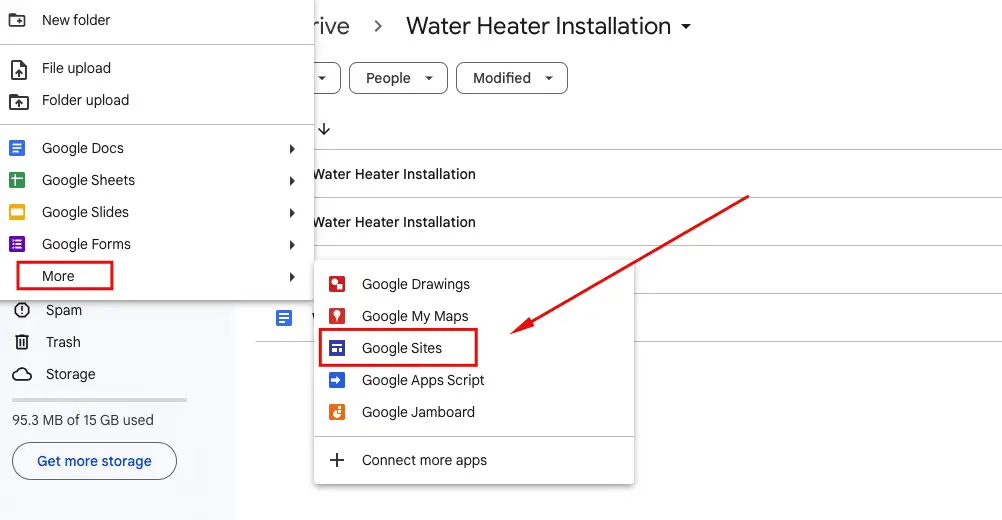Want some magic for link building and SEO in general? ✨
Introducing Google stacking for SEO – a safe and effective way to build links and boost your website rankings.
Note: This is a tactic that has its pros and cons, but I assure you that if you don’t do any black hat thingies, you will be surprised with the results!
Follow along as I will show you how to use this strategy to boost your site’s authority and attract organic traffic. I will provide examples and actionable tips, easy to understand and implement.
So, let’s get started!
What is Google Stacking?
| Google stacking, also known as Google entity stacking, is a link building technique that involves creating links to your website using various Google properties. Unlike traditional link building methods that rely on external websites, Google stacking for SEO utilizes the power of Google’s own ecosystem to build backlinks and establish authority. |
But what exactly are these Google properties? Well, they include Google Docs, Google Sheets, Google Maps, Google Forms, and Google Slides. All of which, I am sure you are very familiar with.
By leveraging these properties, you can create valuable digital real estate that not only helps grow your online business but also boosts your SEO efforts.
Do You Need a Google Stack?
Before we delve into the details of how to create a Google stack for SEO purposes, let’s first understand why it’s essential for your online business.
Okay, you don’t need it, but it can be very beneficial. Here’s why ⬇️.
Why You Need a Google Stack for Your Online Business
1. Leverage Google Properties for Link Building
One of the significant advantages of using Google stacking is the freedom it gives you to build backlinks the way you want. Unlike traditional link building methods, where you have to rely on site owners or editors to approve your links, Google stacking allows you to create content using different Google entities about the same topic as your website. By linking them together, you can create an information hub that is helpful to your intended audience.
Furthermore, by creating multiple Google stacks covering different subtopics and linking them to each other, you can increase your website’s domain authority faster.
2. Diversify Your Content Strategy
Another benefit of Google stacking is the ability to establish a content strategy outside of your website. While guest blogging and partnering with influencers are effective ways to broaden your online footprint, they come with limitations. You have to follow site editorial guidelines or set rigid guidelines for influencers, which may compromise your content or restrict their artistic freedom.
With Google stacking, you have full control over what goes into your Google authority stack. You can create the best possible Google authority stacks that point to your site without worrying about compromising your content.
3. Improve Reputation Management
Reputation management is crucial for every business. Negative reviews can harm your brand’s image and drive potential customers away. But with Google stacking, you can combat negative reviews by creating content on your site and ranking them on Google. By ranking your stack for target keywords, you can offset negative results on search engine results pages (SERPs) and even outrank them.
Now that we understand the importance of Google stacking let’s dive into the step-by-step process of creating a Google stack for your online business.
Must Read: ➡️ The Ultimate Guide to Link Building in 2024 [Beginner Friendly]
How to Stack Google Sites?
Step 1: Sign Up for a Brand New Google Account
To start building your Google stack, sign up for a brand new Google account. This will ensure that the Google stack you create is treated as separate from your existing Google properties associated with your site or brand. Creating multiple stacks can expedite entity authority, but for now, let’s focus on building a single stack.
Step 2: Create Google Drive Folders and Subfolders Using Your Keywords
To optimize your Google stack, you need to plot out which keywords you want to target for each Google property. Consider keywords related to your niche or those with a strong correlation to your homepage.
For example, if you have a plumbing business, you might want to create a stack targeting keywords related to plumbing services.
Once you have a list of keywords, create folders in your Google Drive. The first folder should be named after your niche, and inside it, create subfolders using the keywords you researched. Make sure to make these folders available for public viewing to allow search spiders to crawl and index your assets.

Step 3: Create the Assets
Now it’s time to create the assets using Google properties. Use the same keyword for each asset’s filename as the corresponding folder. Treat the content you create for these assets as if you’re publishing them on your site, ensuring high quality and relevance.

Remember, you’re not limited to just creating articles (Google Docs). You can also create forms (Google Forms), presentations (Google Slides), and more. Link back to your site’s homepage or relevant pages from these assets to build link signals that increase your website’s authority.
After completing the content for each asset, make sure to publish them for the web to ensure they are crawled and indexed by Google.
Don’t forget: Make the folders and docs available for public viewing.

Don’t forget (this as well): Once you’ve finished creating the content for each asset, be sure to publish them online.

Step 4: Create a Google Site that Interconnects Your Assets
To make sense of the Google stack you’ve created, create a website using Google Sites. This simple web page builder allows you to link or embed the assets you’ve created in your Google Drive in just a few minutes.

Your Google site should serve as an information hub about your target keyword, interconnecting pages optimized for the same keyword to increase topical relevance. Choose a pre-made template or start with a blank page and customize it to your liking. Add short copy optimized for the target keyword and include relevant assets and boilerplate pages like About Us and Contact.
Pro tip: Use a pre-made template to make stuff faster and easier. For this matter, it’s not crucial that every aspect of your website is custom-made.

Once you’ve added everything, click Publish aaaand make your site live.🥳 This will allow search spiders to crawl your site and potentially appear on Google search results for its keyword.
Step 5: Share Your Stack with the World
Increase the visibility of your Google stack by promoting it on social media platforms. You can also embed some of the assets in your site’s blog posts to provide additional value to your audience.
Pros and Cons of Google Stack SEO
As with any SEO strategy, it’s important to understand the pros and cons of Google stacking. Here are some key points to consider:
🙂 Pros:
- Easy to manage and complete control over content creation and link building
- Low risk of penalties since you’re using Google properties
- Ability to diversify your content strategy and establish a strong online presence
🙁 Cons:
- Requires constant creation and updating of assets, which can be time-consuming
- Link signals from Google stacks may not be as strong as those from third-party authoritative sites
Wrap up
Google stacking is a powerful SEO strategy that can help boost your website rankings and establish authority. By leveraging Google properties, you can create valuable digital real estate that drives organic traffic to your site. Through careful keyword research, content creation, and interlinking, you can maximize the potential of your Google stack and improve your overall SEO efforts.
So, what do you think? Worth testing out, ha?
Start building your Google stack today and watch your website soar to new heights in search engine rankings!
Have you read this? ➡️ How to do SEO in 2024 – the Ultimate Guide [Beginner Friendly]
Don’t forget to reach out if you have any questions, if you need a hand or just want to brainstorm your Google stacking strategy!



